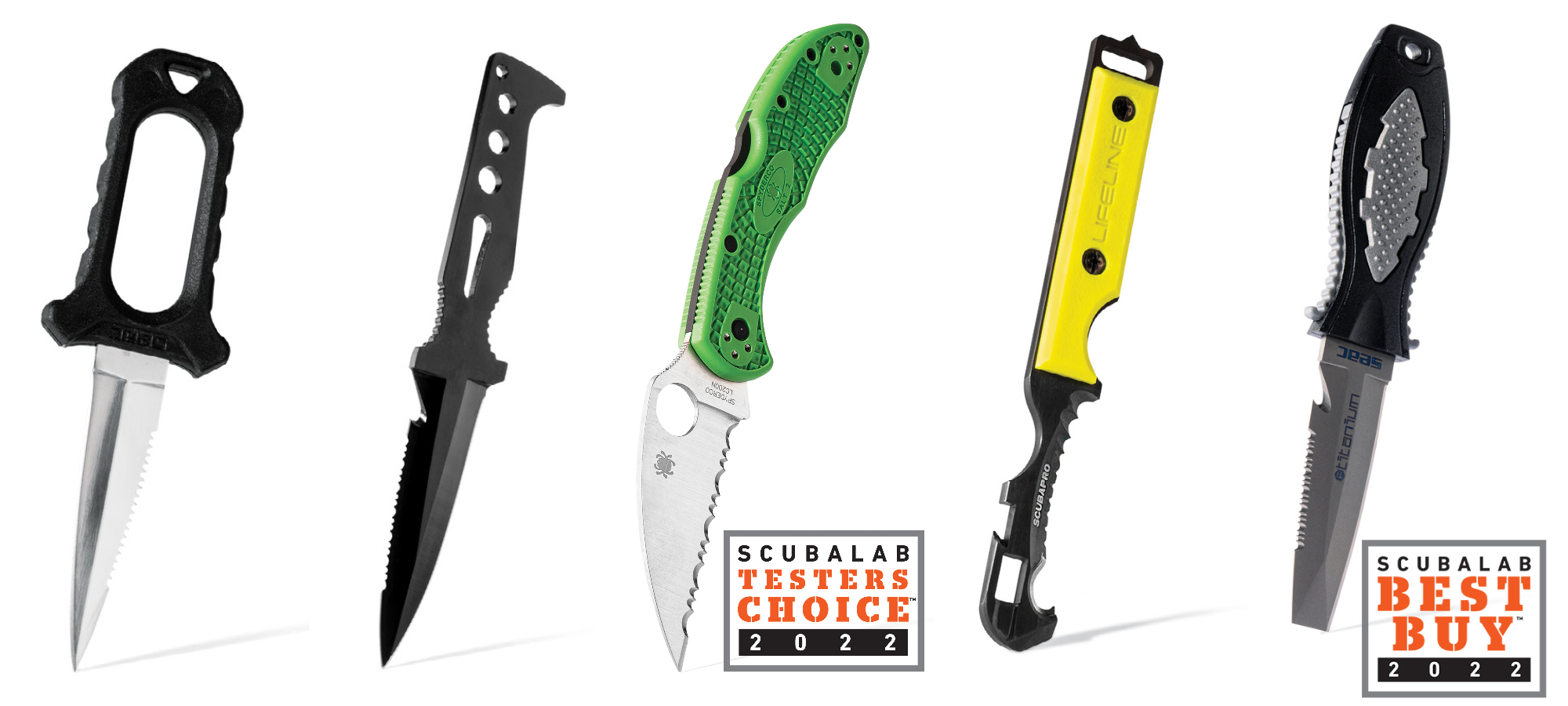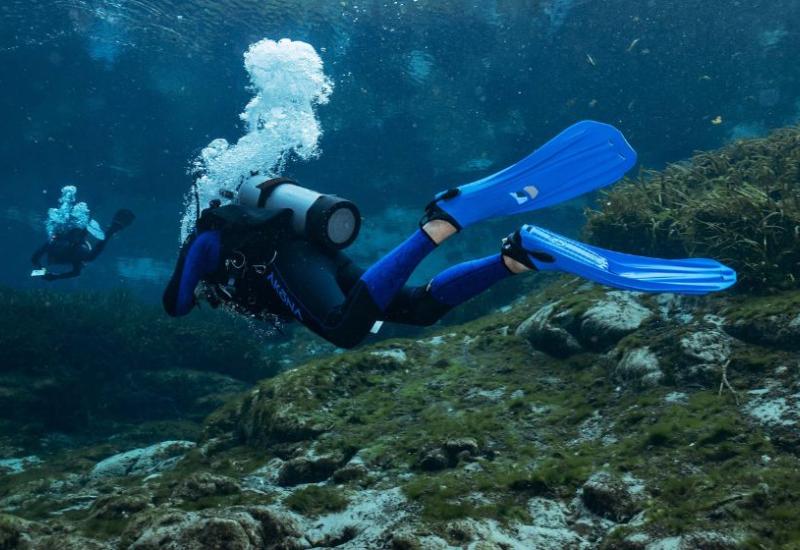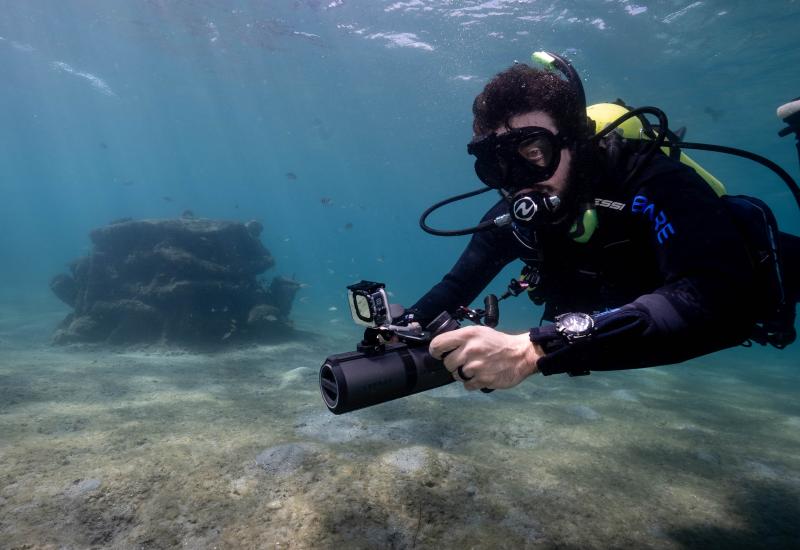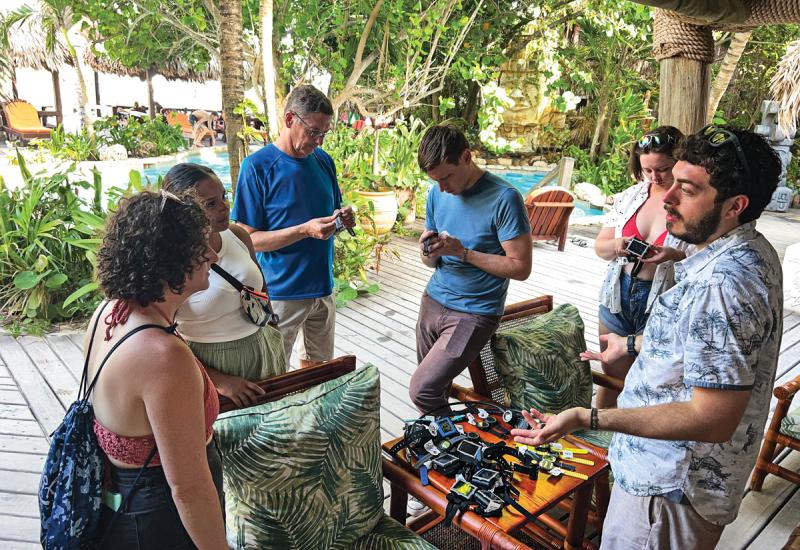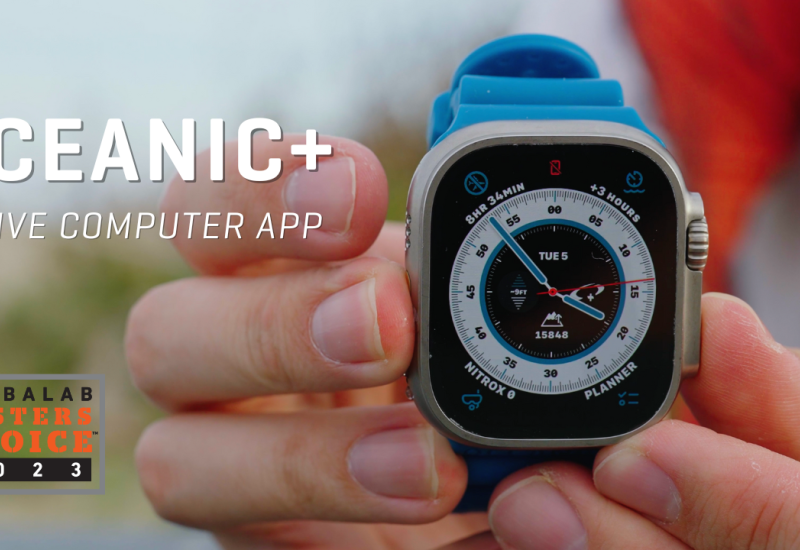16 Dive Knives and Cutting Tools Reviewed by ScubaLab
Head-To-Head Testing
How We Test
Our test was designed to gauge each knife’s cutting ability, ergonomics and suitability for dive use, and its durability and corrosion resistance.
Cutting Ability

Robby MyersThe ScubaLab Team testing each knife.
We gauged the ability to cut through hand-held loops of four materials: heavy-duty (.095-inch) plastic trimmer line; 1⁄4-inch hollow polypropylene; 3⁄8-inch manila; and 1⁄2-inch three-strand twisted polypropylene. We chose these because they’re typical of the materials in lines and nets encountered by divers.
If a knife could cut a line in a single pass, a double thickness was attempted. After all four lines were cut, the knife was used to make 20 repetitive cuts. Then the four cuts were attempted again to gauge whether the blade had lost any of its edge.
Cuts were scored as follows:
- 5=very easy to cut in one pass
- 4=easy to cut in one pass
- 3=possible to cut in one pass
- 2=required multiple passes to cut
- 1=very difficult to cut.
The knives were also used to cut materials including multistrand copper electrical cord and heavy nylon zip ties in order to gauge each knife’s strength and ability to withstand abuse.
Ergonomics
Knives were scored for performance of their grips, sheaths, and locking mechanism, including:
Security of sheath or folding lock
Ease of removing and replacing from sheath (with and without gloves)
Security/comfort of grip when cutting
Feel, fit and finish of the knife
Durability
These tests were designed to determine a knife’s resistance to breaking or rusting.
Pry test —The blade was inserted 1 inch into a block of wood, and a 10-pound weight was hung from the end of the handle to gauge its strength.
Corrosion resistance —This was intended to replicate a day of diving followed by gear maintenance, as well as situations where rinsing gear might be delayed. Knives were submerged in salt water for six hours, then rinsed in fresh water, disassembled where possible and dried. Next the knives were submerged and left in salt water for 24 hours, then rinsed, disassembled and dried. After each submersion, knives were carefully inspected for corrosion.
RESULTS
SPYDERCO — SALT 2 GREEN LC200N WHARNCLIFFE
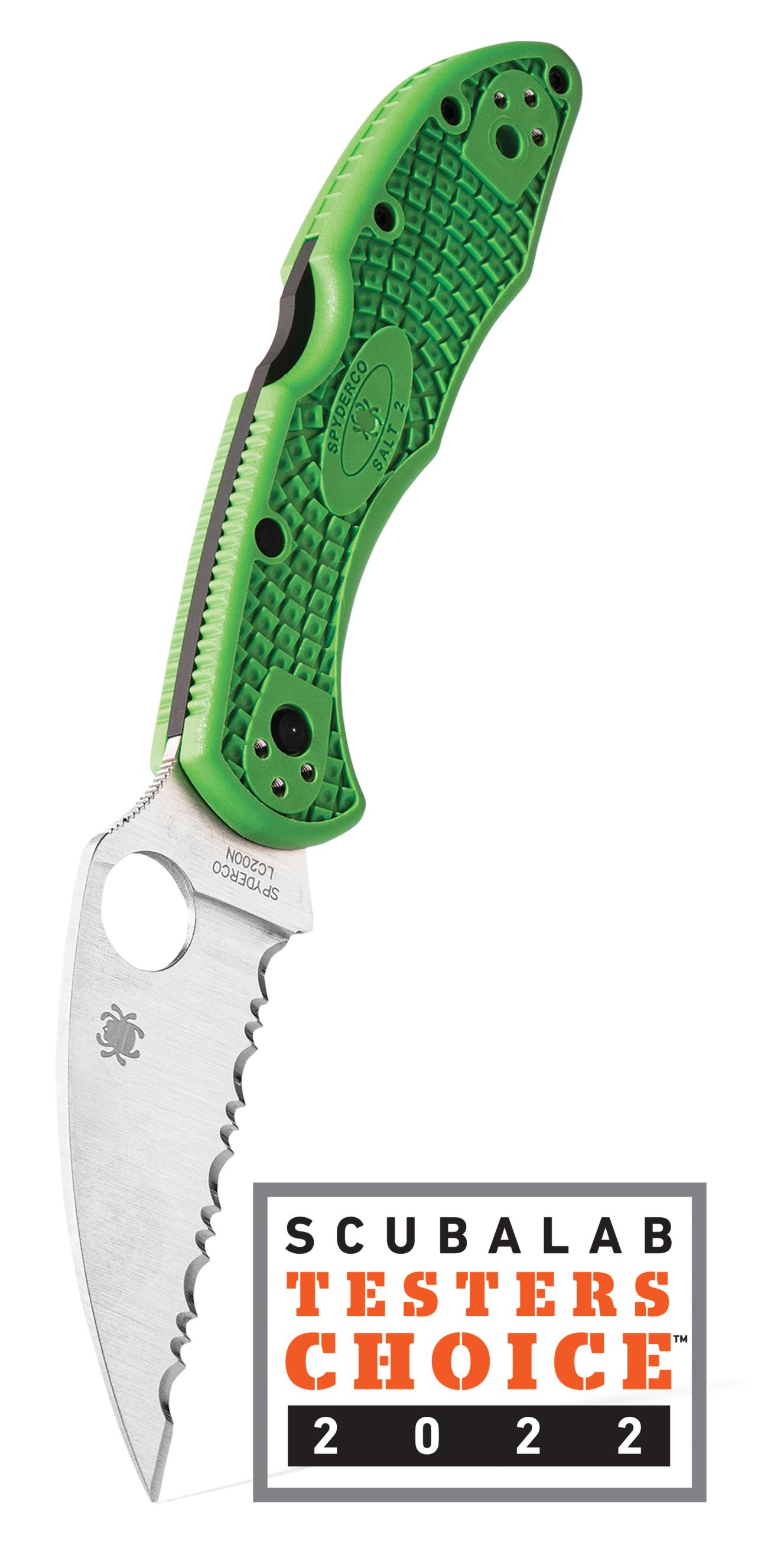
Monica MedinaMSRP $177.50
CONTACT spyderco.com
This folding knife is equipped with a 3-inch full-flat-ground Wharncliffe-style blade and is available with either a PlainEdge or fully serrated SpyderEdge. Made of nitrogen-enriched LC200N steel, the blade offers extreme corrosion resistance and was no worse for wear at the conclusion of our 24-hour saltwater soak. It earned a perfect score for cutting, effortlessly slicing through single and double strands of each of our test lines. The bright-green handle is ergonomic for comfortable cutting and features heavy texturing to improve grip when wet. It scored excellent for security and ease of grip when cutting. The lock mechanism is rock-solid and offers easy one-handed deployment of the blade. “Couldn’t be more secure or safer to carry/store in dive gear,” one tester commented. The knife is very lightweight, but features solid construction and corrosion-resistant parts. “Feels and looks like a serious tool,” one tester said. A favorite of testers that cuts like crazy and thrives in salt water, the Salt 2 LC200N Wharncliffe is our Testers Choice for compact dive knives.
EDGE — QUICK LOCK ASSASSIN
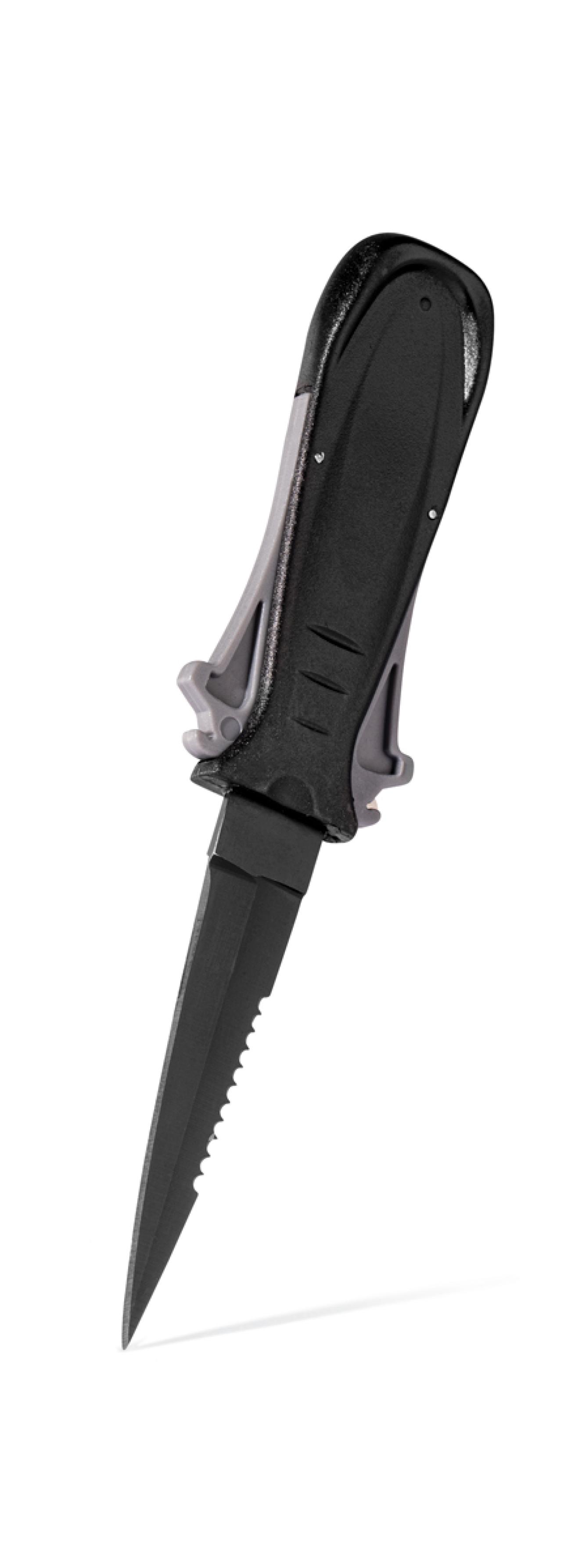
Monica MedinaMSRP $24.95
CONTACT edge-gear.com
The Assassin’s short, daggerlike blade would quickly dispatch a spearo’s catch with little effort. It’s ability to cut line, however, left a lot to be desired. The blade bounced off harder line, but even when it did manage to bite in, it often took several attempts to cut through. “Serrated edge is definitely the way to go, but you don’t have much to work with,” one tester noted. The knife’s squeeze-lock system scored excellent for security, and the knife won’t so much as rattle when placed in its sheath. Squeezing the grip to remove the knife is straightforward with gloved or ungloved hands. Testers scored the knife excellent for ease of removing and replacing it from the sheath. The grip is small and hard, but fortunately, the locking tabs are situated out of the way so they don’t dig into the palm while gripping hard. The titanium-coated 420-stainless blade held up very well in our corrosion test, with only minimal discoloration along the straight edge.
SEAC — BLUNT
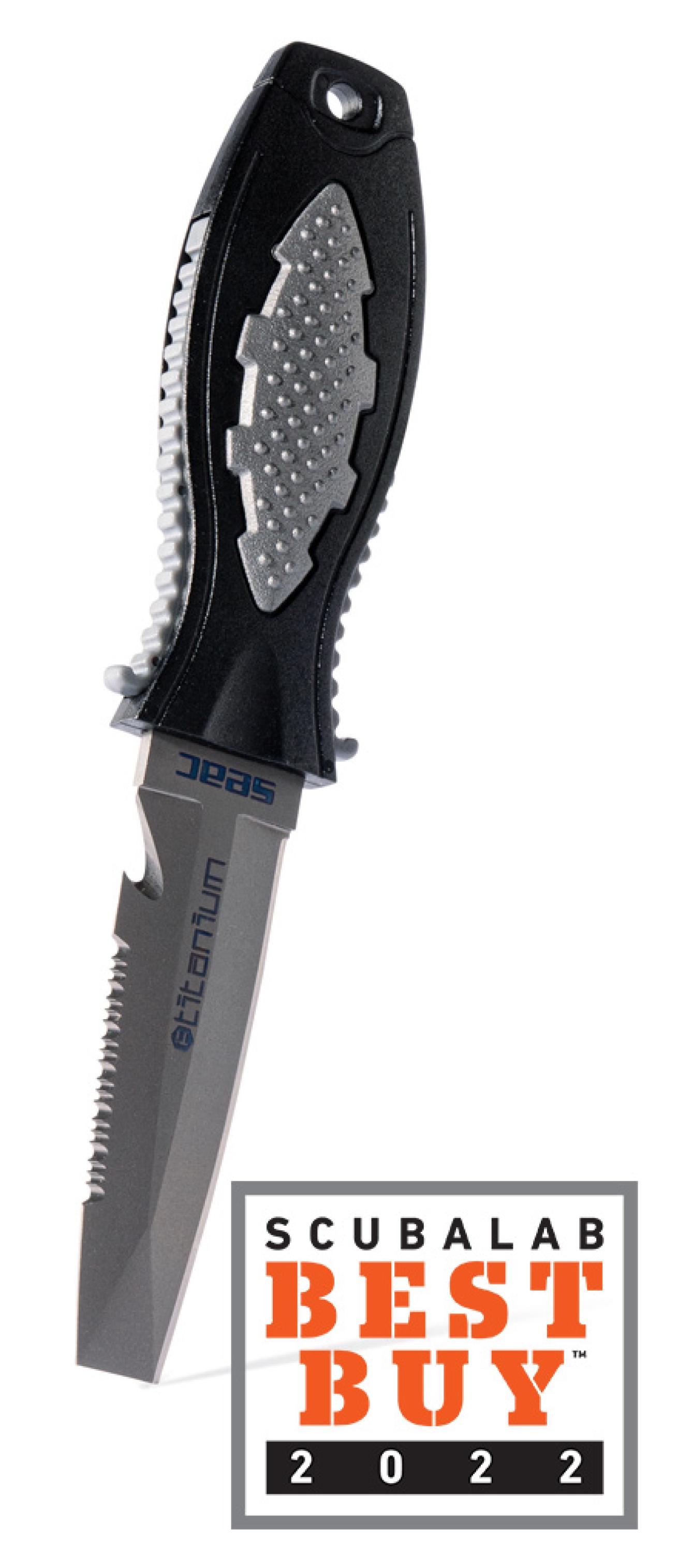
Monica MedinaMSRP $114.90
CONTACT seacsub.com
Utilizing an uninterrupted smooth cutting edge along its 3 3⁄8-inch titanium blade, this eager cutter surprised us with excellent and very good cutting scores. It struggled a bit on the twisted poly, but made short work of everything else. “Stunningly easy. You only get an inch into the blade and you’re through,” one tester said. The hard plastic handle is rounded, with low-profile locking tabs. Testers felt it could use some grippier or more comfortable materials, but otherwise liked the grip. The sheath scored excellent for security and uses two locking tabs that must be pinched together to remove the knife. Testers scored it good for ease of removing and replacing. The springy titanium blade is able to withstand some prying, but 10 pounds seemed to be pushing it. The blade looked like new after sitting in salt water for 24 hours. Offering outstanding cutting performance for a titanium blade at a budget-friendly price, the Blunt is our Best Buy for compact dive knives.
SEAC — DEVIL
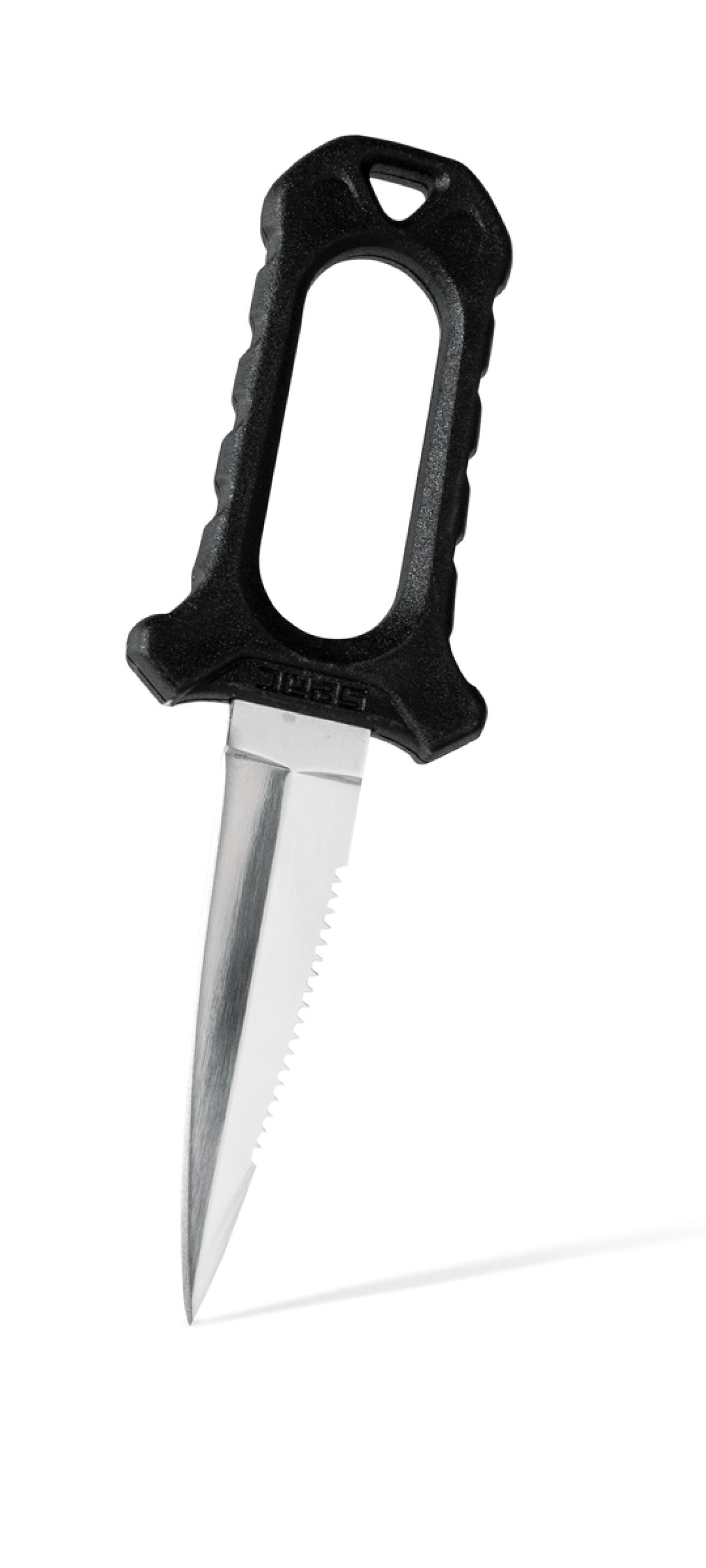
Monica MedinaMSRP $29.90
CONTACT seacsub.com
The Devil’s uniquely shaped handle is wider than most in order to accommodate the large central hole that catches onto the sheath’s oval locking tab to secure the knife. This hurt its score for security and ease of grip while cutting. “Hurts hand and hard to hold,” one tester said about the knife’s grip. The large tab can be disengaged with the thumb for easy one-handed removal. When returning the knife to the sheath however, this locking tab doesn’t always engage, allowing it to pull free without much resistance. This can be prevented by pushing the lock tab up from underneath to ensure it engages. The smooth edge of the shiny stiletto-tip blade struggled to bite into our test lines, and the large serrations struggled to retain line during sawing. “Rips more than it cuts,” one tester noted. Although most of the corrosion accumulated during our 24-hour saltwater soak wiped off, there was a fair amount of rust where the blade meets the over-molded handle.
SPYDERCO — SALT 2 GREEN LC200N
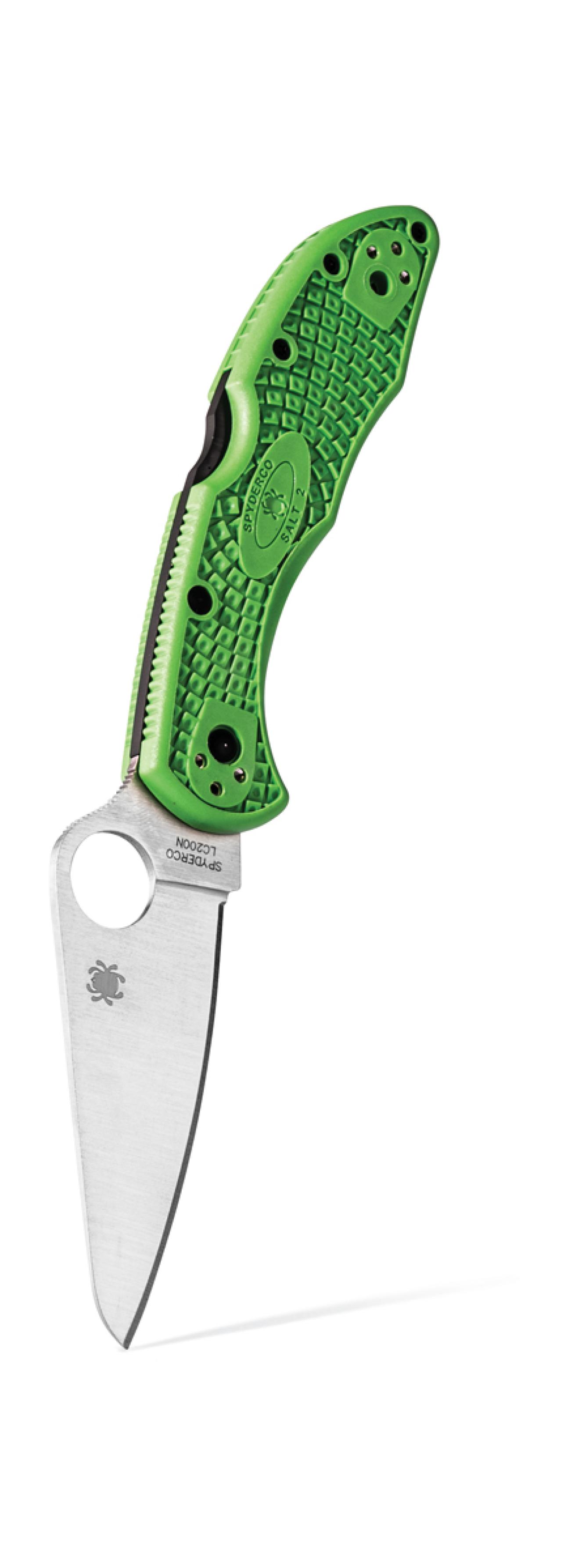
Monica MedinaMSRP $177.50
CONTACT spyderco.com
This latest iteration of Spyderco’s original Salt 2 model features a new ultra-corrosion-resistant LC200N martensitic blade. We couldn’t get the thing to rust, even with our best efforts, and its low-friction, full-flat ground edge—available with a choice of PlainEdge or fully serrated SpyderEdge—cut through everything we could throw at it and didn’t miss a beat. It earned a perfect score for cutting across all of our test lines. When closed, this lightweight folding knife measures only 4 1⁄4 inches long, making it easy to stow just about anywhere. It scored excellent for opening and closing the knife. A large thumb hole allows the knife to be opened easily with a single hand. Made of fiberglass-reinforced nylon, the handle is strong and durable. Its comfortable shape and bidirectional texturing enhance grip security, for which it scored excellent. “Perfect fit in my hand,” one tester noted. The Salt 2 Green was a favorite among testers.
CRESSI – KAI
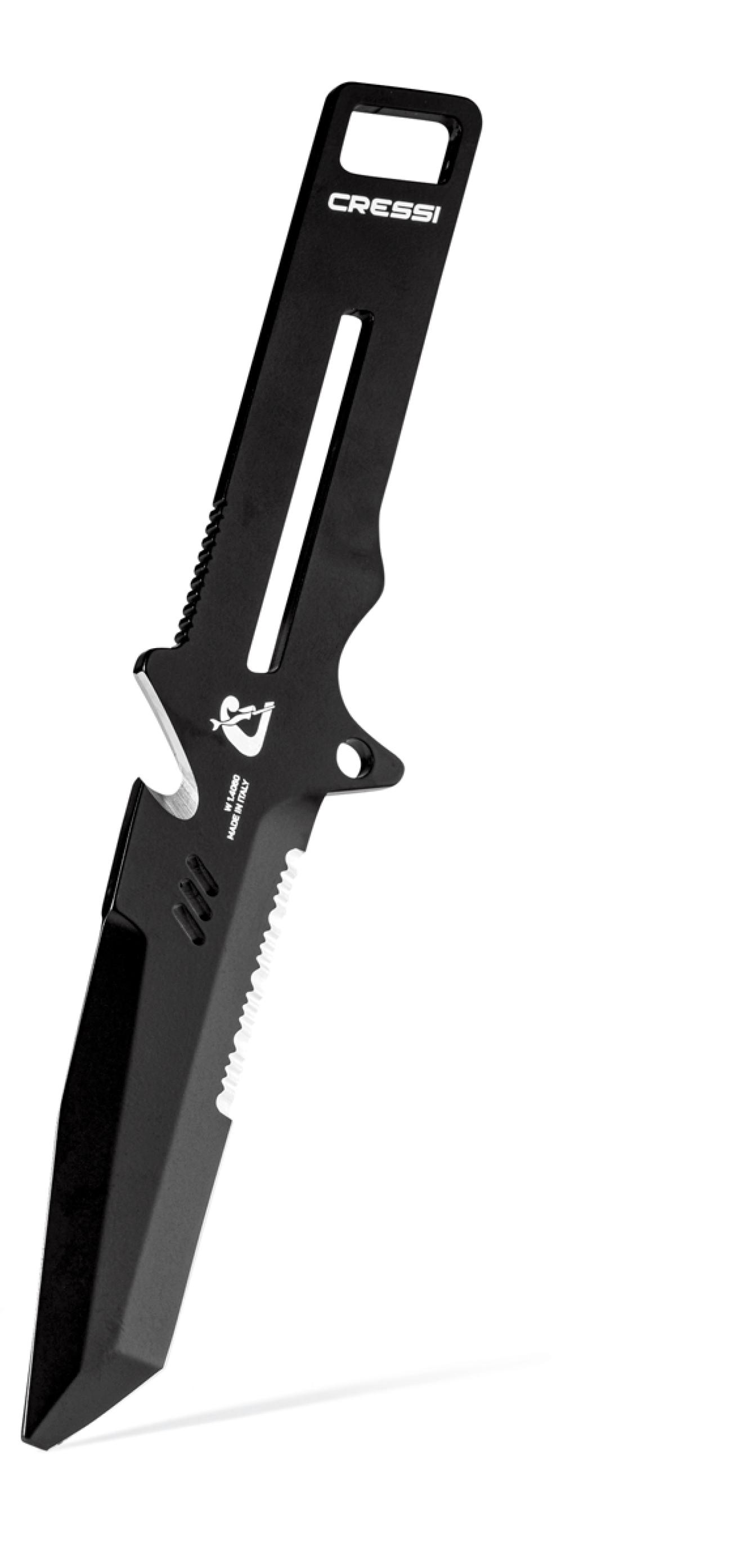
Monica MedinaMSRP $59.95
CONTACT cressi.com
This skeletonized knife is made of martensitic stainless steel with an Idroglider Gold Black surface treatment. The snub-nosed blade features a serrated cutting edge at the base of the blade, with straight-edge cutting surfaces near the tip. The alternating large and small serrations are crazy sharp and sliced through our test lines with ease. It scored excellent for cutting hollow poly and manila rope and very good for cutting twisted poly and monofilament. The square metal handle is large enough for a strong grip, but can dig into the palm when cutting hard. The sheath is very secure. However, the knife tends to get hung up on the line cutter on withdrawal, and the snap-button closure can be difficult to open and close, especially in gloves. The stout blade pries and hammers readily. The blade proved to be fairly rust resistant, with only some minor discoloration to its protective coating. A powerful and sturdy cutter, the Kai was a favorite of test divers.
EDGE — QUICK LOCK HUNTER
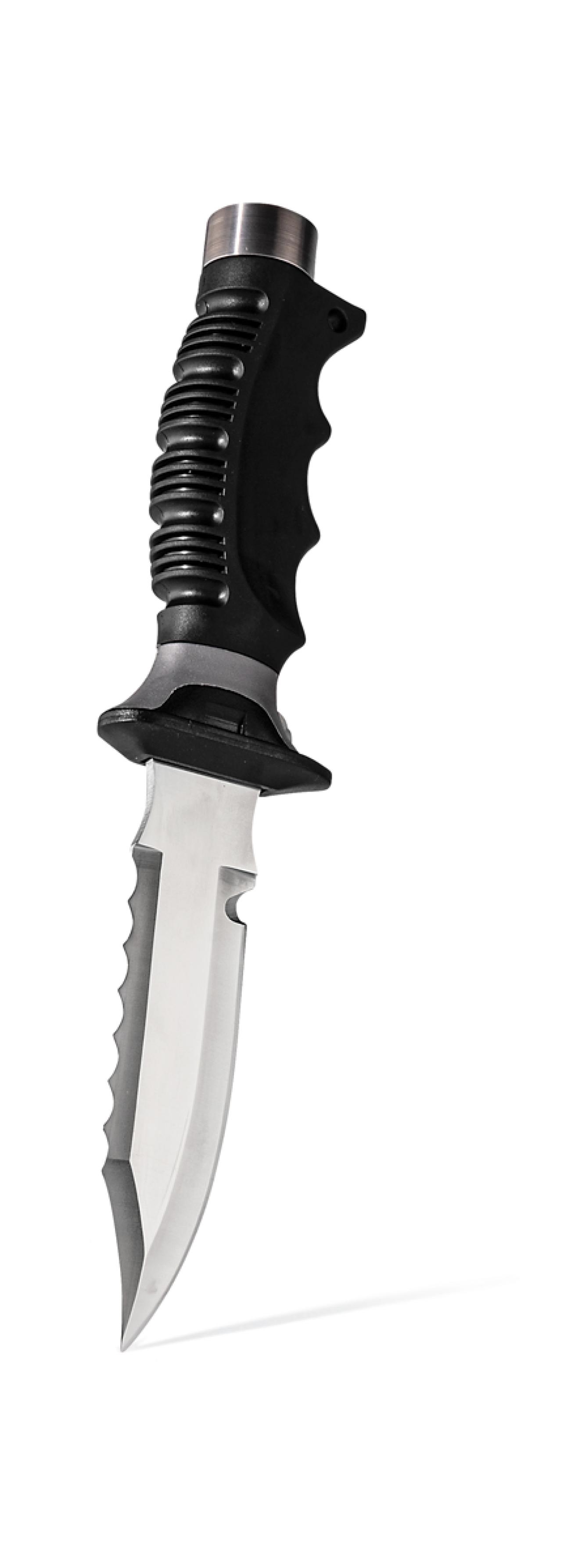
Monica MedinaMSRP $49.95
CONTACT edge-gear.com
This knife’s nearly 5-inch 420 stainless blade proved eager to cut, earning very good and good scores across our test lines. The straight edge scored very good for cutting hollow poly and monofilament. However, testers noted that line can easily get hung up on the line cutter when beginning the cut. The large teeth on the serrated edge sawed through everything but the hard, thin mono-filament with ease. The molded thermoplastic handle provides an excellent grip while using the straight edge. “Very secure and comfortable,” one tester noted. The grip comes apart for cleaning. If you prefer the serrated edge, this also allows you to flip the blade for a better grip. The full-tang knife is incredibly sturdy and features a stainless end cap for hammering or tank banging. The sheath is simple to operate, but not very secure—our testers were able to send the knife flying from the sheath with a bit of vigorous shaking. Still, it wound up as a favorite of multiple testers.
HOG — PRO BCD KNIFE
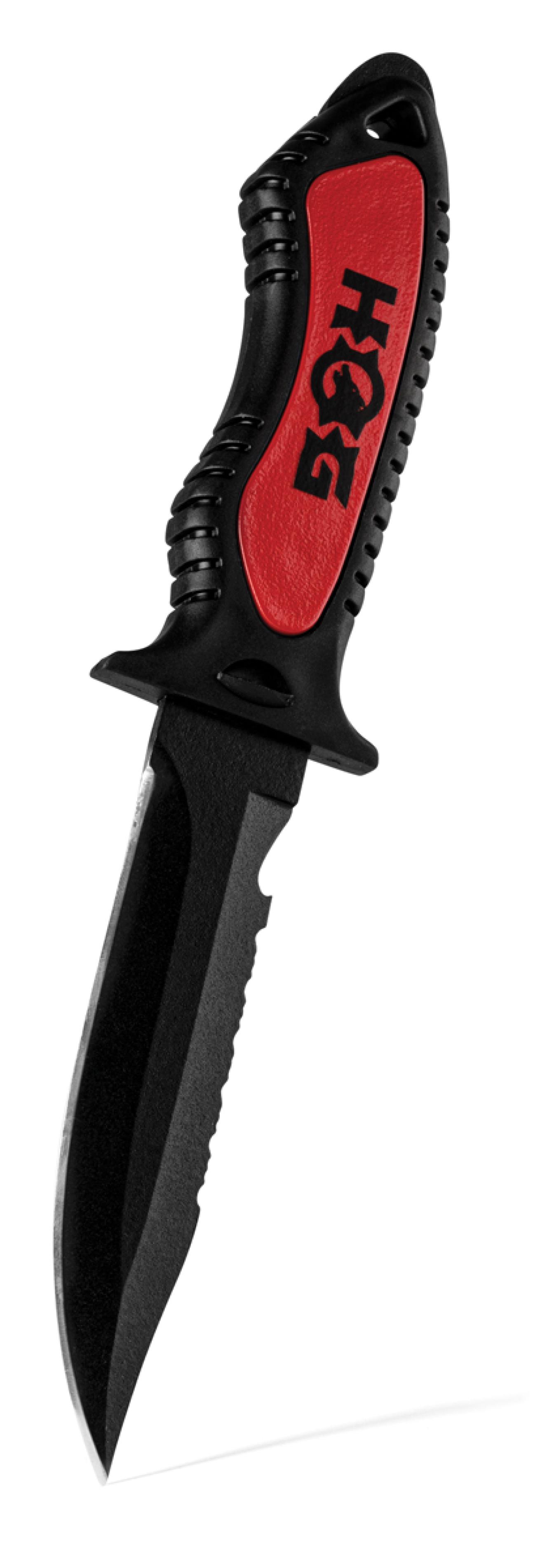
Monica MedinaMSRP $59.95
CONTACT edge-gear.com
This knife scored excellent for overall ergonomics. The curved, textured handle scored excellent for security and ease of grip. “Soft and supportive” and “not a bad shape, material is pretty hand-friendly” were some of the ways testers described it. The sheath features a positive click when the knife is secured and can easily be operated with one hand. It scored excellent for ease of removing and replacing with and without gloves. “Super easy lock and knife pulls out smoothly,” one tester said. The 4 1⁄2-inch blade scored good for cutting through monofilament, but overall, the straight edge struggled to bite into our test line, with testers relying primarily on the serrated edge to get through the other lines. The powder-coated 304 stainless blade held up well in our pry test and our corrosion test. Though some salt buildup was visible where the handle meets the blade, there wasn’t a speck of rust to be seen.
RIFFE — EDC 4.5
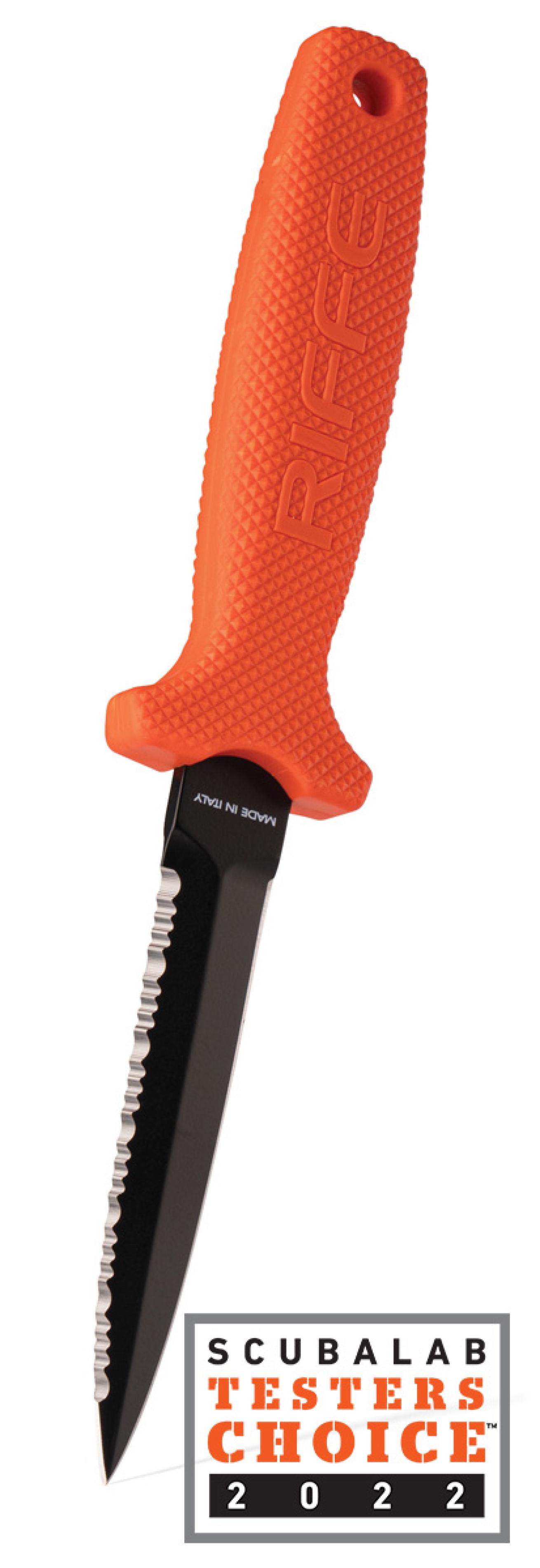
Monica MedinaMSRP $64
CONTACT speargun.com
Measuring a total 9 inches in length, this dive knife offers plenty of blade and a generous grip that made for easy, comfortable cutting. It earned an excellent score for overall cutting performance. The smooth edge is more useful for spearing fish than line, but the razor-sharp serrated edge, with alternating large and small teeth, sliced through everything but the mono-filament in a single pass. The bright-orange handle is ergonomically curved and features a textured, rubbery coating for a sure grip. “Perfect shape for my hand. Ambidextrous grip is very useful,” one tester said. Be sure to rinse the 420 stainless blade right away, as our knife did suffer some minor pitting during our corrosion test. The traction-lock sheath scored excellent for security and very good for ease of removing and replacing. The knife is well-balanced and sturdy enough for moderate prying. A favorite of testers, with outstanding performance, the EDC 4.5 is our Testers Choice for full-length dive knives.
SEAC — SHARP
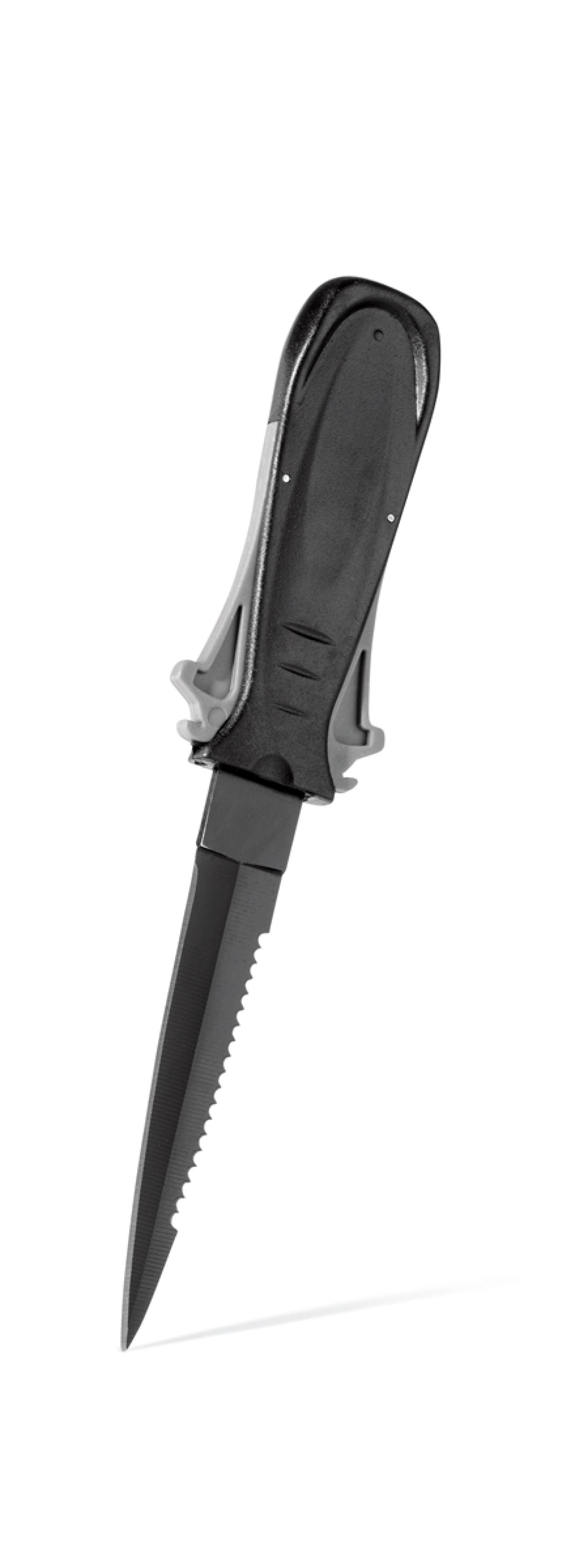
Monica MedinaMSRP $39.90
CONTACT seacsub.com
This knife scored excellent for the security of its sheath thanks to its squeeze-lock system, which holds the knife firmly in place but can easily and quickly be removed with a single hand. “Stays put. Rattles very little,” is how one tester described it. The 3 1⁄2-inch-long blade is narrow, with an uninterrupted straight edge on one side and a serrated cutting edge on the other. The straight edge cut through hollow polypropylene in a single pass, but the serrated edge had better luck with the manila and three-strand twisted polypropylene. The thin, hard monofilament tended to bounce off the knife’s big serrated teeth and was very difficult to cut. The hard plastic handle is a bit slippery when wet. When cutting or sawing hard, the squeeze tabs on the sides of the grip dig into the hand. The long blade is pretty springy, and isn’t suitable for hard prying. After sitting in salt water for a day, the knife sported only a little rust, all of which easily wiped off.
SEAC — TAJAMAN
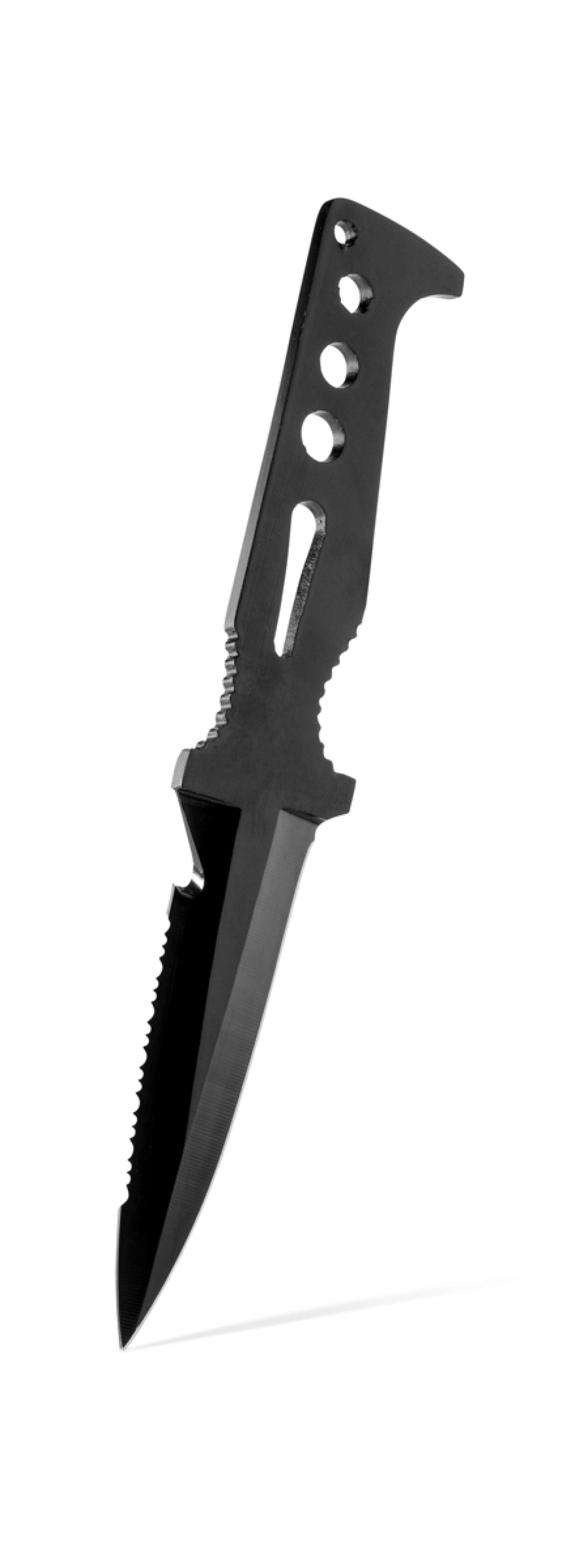
Monica MedinaMSRP $39.90
CONTACT seacsub.com
Coated with a black Teflon treatment, this one-piece 420 stainless-steel dive knife survived our six- and 24-hour salt water immersions with only a few spots of discoloration. The skeletonized blade is well balanced and strong enough for hard prying. The smooth edge is sharp, but struggled with cutting our test line. The serrated edge helped to pick up the slack somewhat, but the line cutter tended to snag while sawing back and forth through thick rope. The bare handle is just long enough to hold, and has several angular features that dig into the fingers and palms, even when cutting with moderate pressure. “Every way I hold it hurts my hand,” one tester complained. The Velcro-secured nylon webbing sheath holds the knife tight and snug. It scored excellent for security. The knife is inserted all the way up to the tip of the handle, which doesn’t leave anything to grab onto when withdrawing the knife from the sheath unless you have a lanyard attached.
CRESSI —KAI MINI
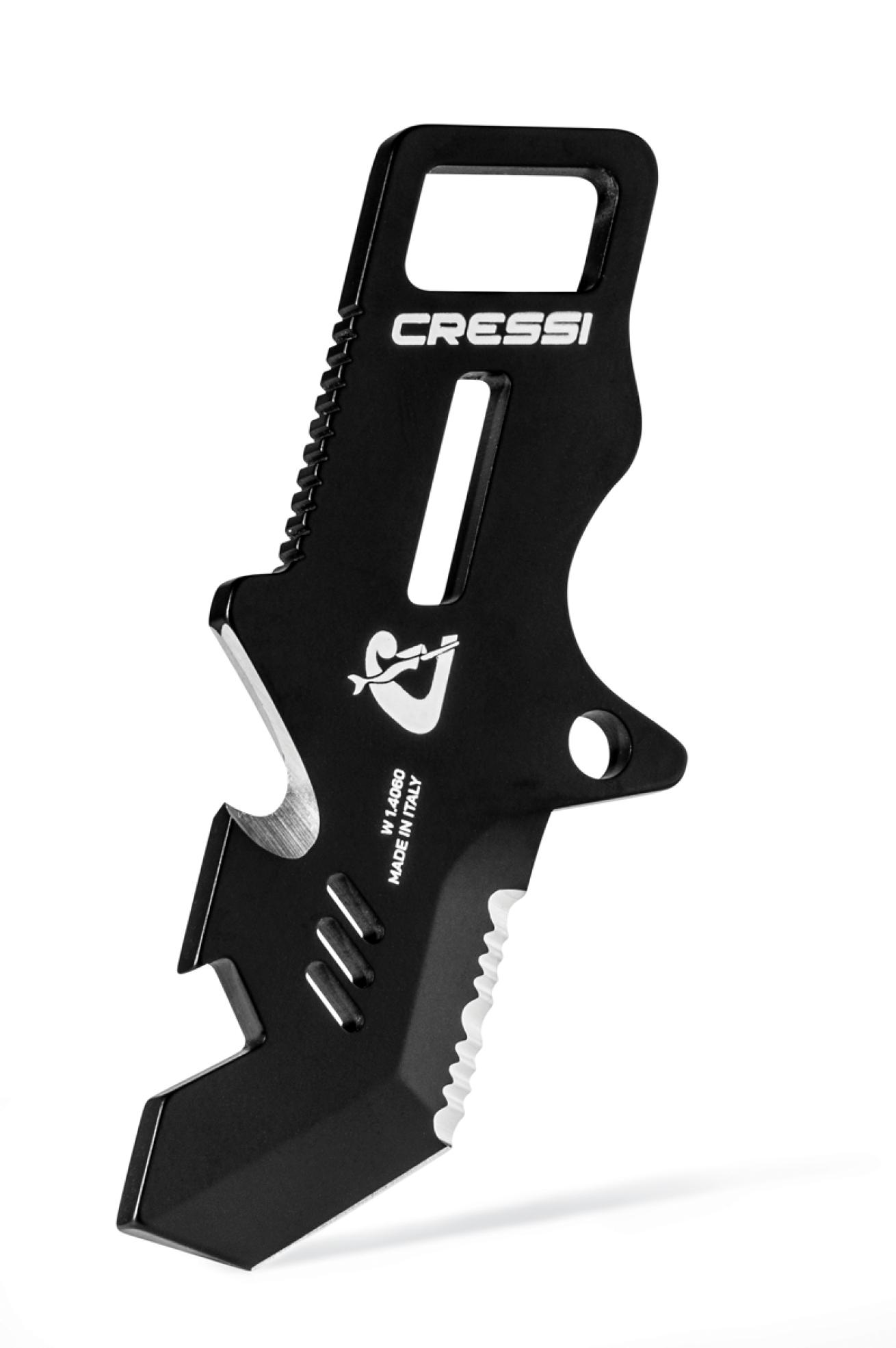
Monica MedinaMSRP $49.95
CONTACT cressi.com
This miniature version of the Kai shares the basic design of the original, but in a truncated form—although this version also includes a built-in bottle opener. The abbreviated cutting edge is still razor-sharp, but it just doesn’t have enough length to get through most line without multiple passes. The flat, skeletonized grip is equally small, which makes it very difficult to put any power behind your cuts and doesn’t allow for much control of the blade. The tiny grip also puts your fingers a little too close to the blade for most testers’ liking. “Couldn’t really cut line, but nearly cut myself,” one tester noted. The compact ballistic sheath can easily be mounted to a BC strap or via the attached D-ring, making the Kai Mini easy to take along on any dive. It scored very good for security but poor for ease of removing and replacing due to the line cutter snagging on the sheath and the difficulty of securing the snap-button closure. Like the larger Kai, the Mini held up well in our corrosion test.
DIVE RITE — LINE CUTTER WITH CERAMIC BLADE
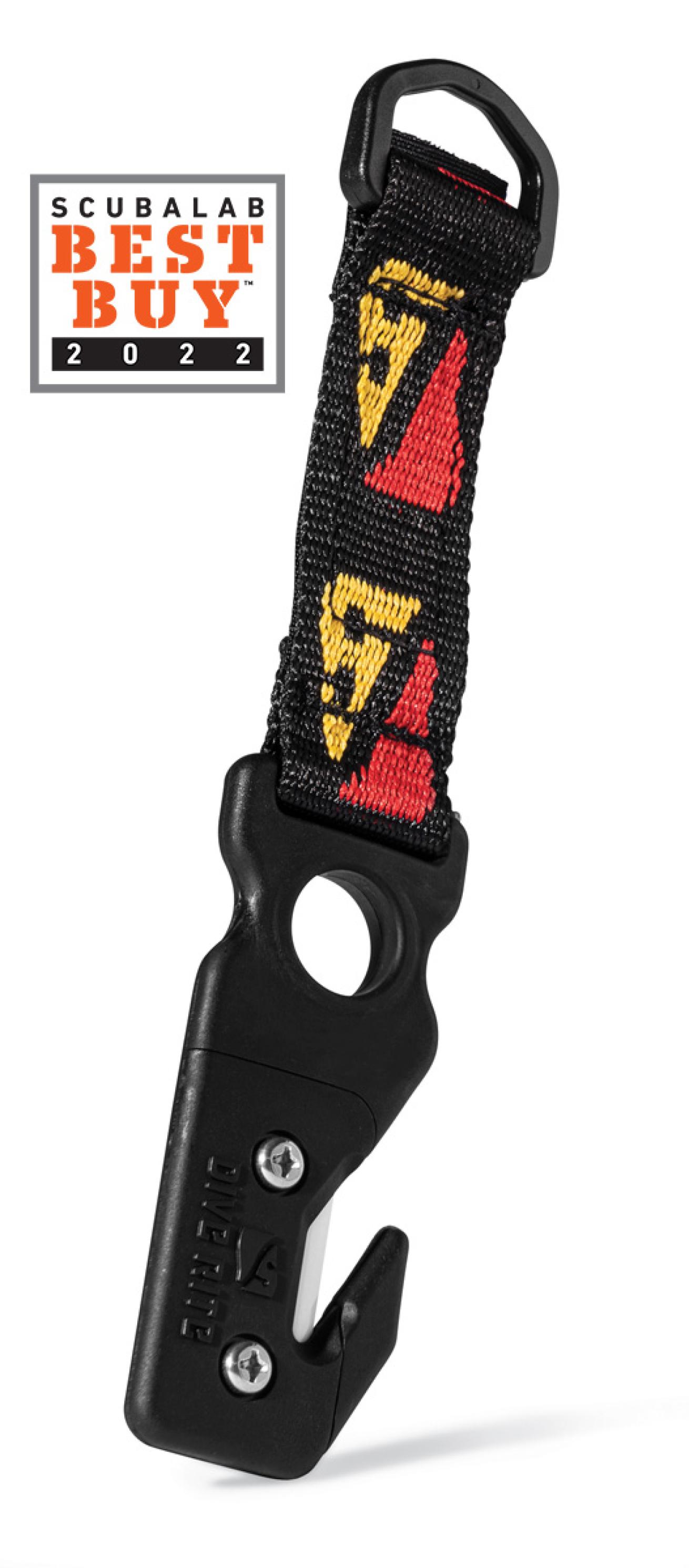
Monica MedinaMSRP $24.95
CONTACT diverite.com
This line cutter uses a ZrO2 ceramic blade. Unlike stainless razor blades, which will rust readily in salt water, it remained spotless after both a six- and 24-hour soak in salt water and cuts just as eagerly. It scored very good for cutting manila rope and excellent for cutting monofilament and hollow polypropylene. It cut the twisted poly, but only after working it into the cutter’s narrow jaws. The nylon sheath can be mounted vertically or horizontally on webbing up to 2 inches wide. The cutter is secured via Velcro and is almost impossible to accidentally release. It scored excellent for security and ease of removal and replacement. The compact housing scored just good for security of grip, but it cuts so easily that it hardly matters. We did manage to chip the blade with enough abuse, but it still was able to cut fine. Capable and convenient, this ceramic line cutter is our Best Buy for cutting tools.
SCUBAPRO — JAWZ TI
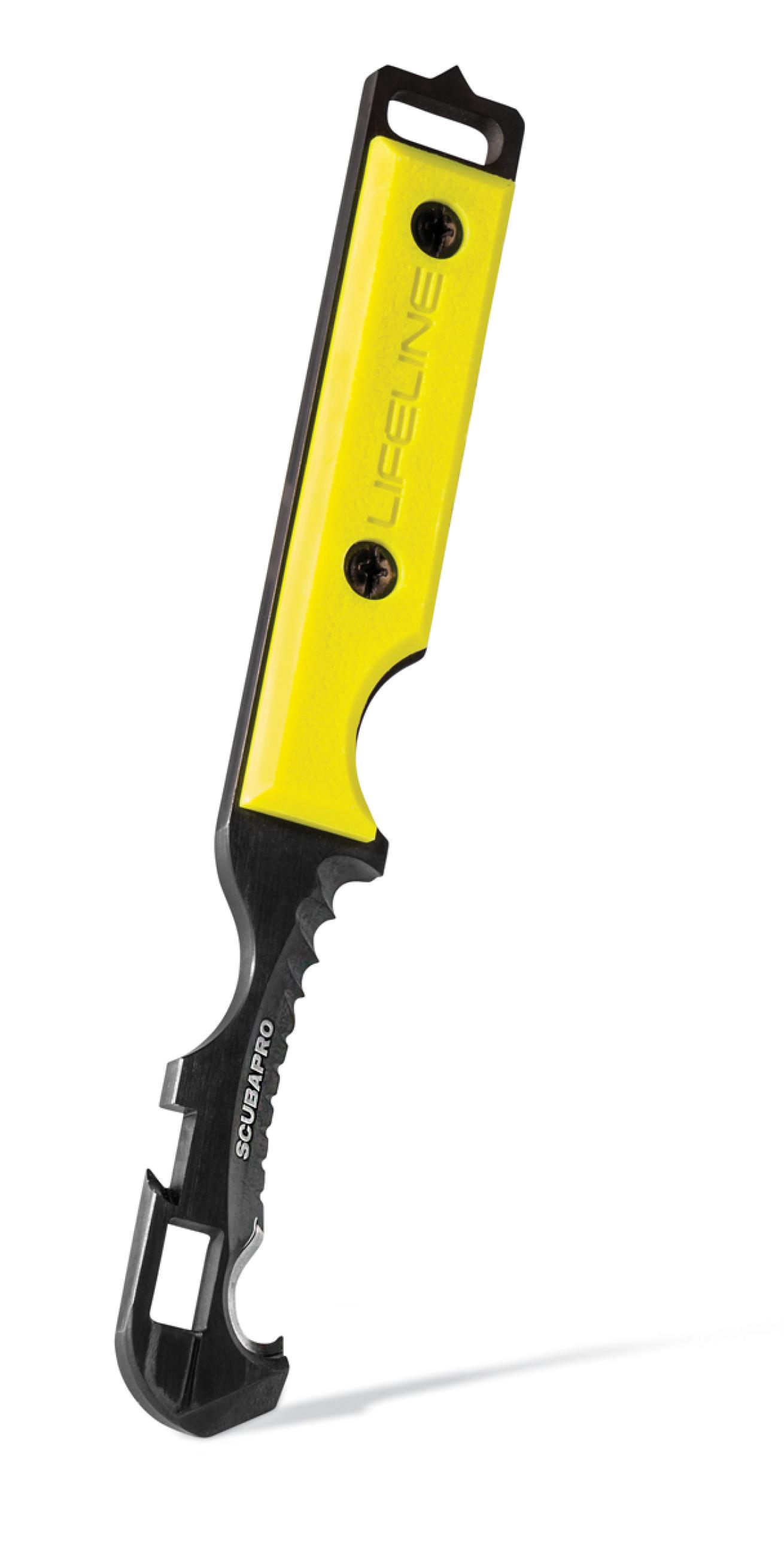
Monica MedinaMSRP $280
CONTACT scubapro.com
This premium tactical rescue tool features several solutions for addressing underwater emergencies, including a serrated cutting edge, line cutter and glass breaker. It scored good for sawing through our more fibrous test lines, but the large serrations struggled to catch on the thinner trimmer line. The large, square grip provides plenty of leverage during hard cuts, but isn’t the most comfortable. The thick titanium blade—almost 1⁄4-inch thick—makes a stout tool for prying and hammering. The sheath lock requires a firm tug to disengage, and is very secure—at least when the knife is inserted correctly. The knife can be inserted upside-down, which makes it much less secure and will scratch the blade. The titanium blade and corrosion-resistant thermoplastic sheath were unmarred by our saltwater soak, but plenty scuffed from such misalignment. Available in black or glow-in-the-dark yellow for increased visibility during emergencies.
TEKNA — GATOR EDGE
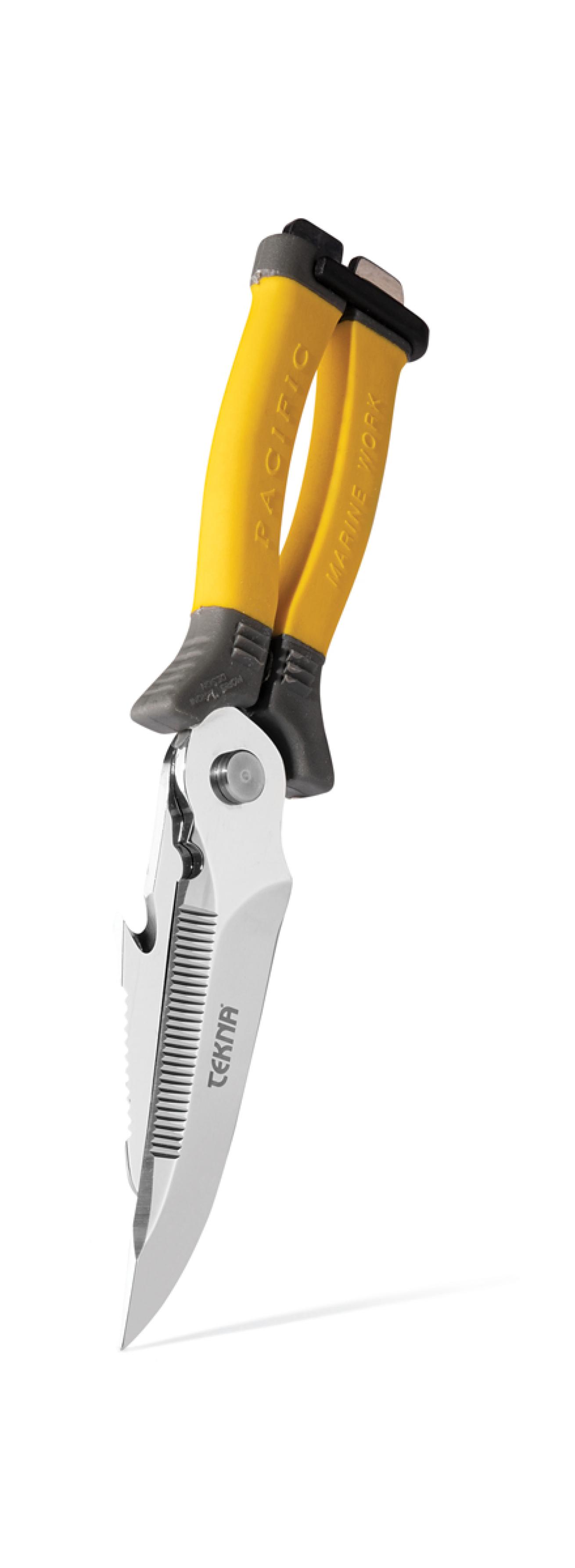
Monica MedinaMSRP $269.95
CONTACT tekna.us
Sporting a massive 5 3⁄8-inch 420 stainless-steel blade and lots of sharp moving parts, this hybrid knife/shear can be a bit intimidating. And its bite is just as powerful as its bark. The shears chomped through our test line with little trouble and earned a very good score overall for cutting. The thicker twisted polypropylene line slowed it down, but didn’t stop it. “Like a nice pair of my mom’s garden shears,” one tester commented. Rubbery grips have a slight curve for additional comfort and don’t hurt the hand during hard cuts. It scored very good for security and ease of grip. The sheath has three beefy locking tabs, which require a substantial amount of pressure to clear. That and a separate locking mechanism mean the knife won’t come free accidentally. “Tighter than the sword in the stone,” one tester quipped. A thorough cleaning is necessary to prevent rust from forming, especially given the knife’s many different metal surfaces.
TEKNA — RESCUE EDGE
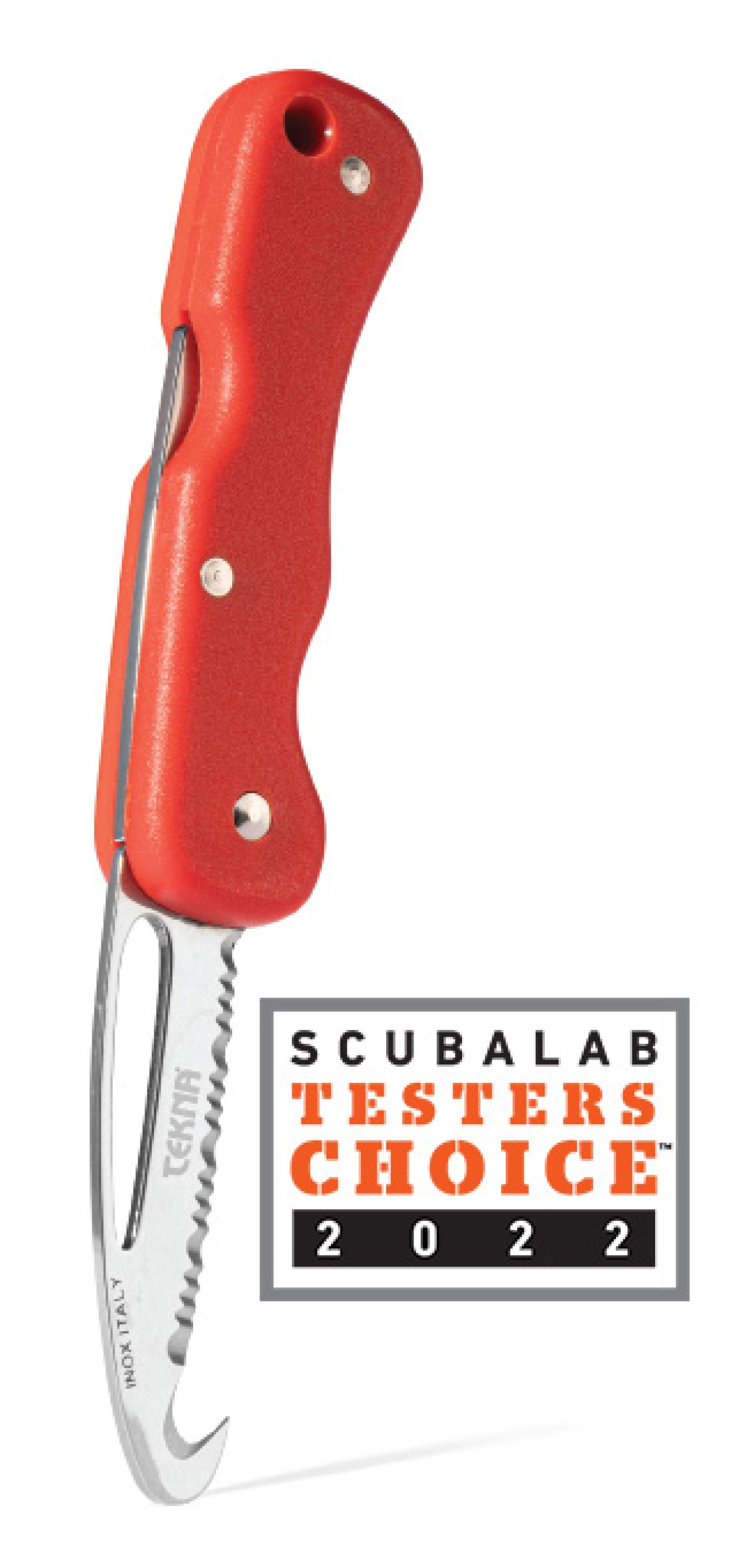
Monica MedinaMSRP $49.95
CONTACT tekna.us
This folder’s 3-inch serrated blade made short work of our test line. “Cuts like crazy,” one tester said. It uses a blunt-tip “rescue-hook” design, which allows it to get in close without risking accidental injury. These two features make it ideal for sawing through taut line to free tangled limbs without accidentally nicking hoses, arms, legs or flippers. It scored excellent for cutting hollow poly, manila and monofilament. It took a bit more effort to chew through twisted poly, for which it scored very good. The thick, curvy fiberglass-reinforced handle provides an excellent grip. “Perfect shape and size for my hand,” one tester said. Though it doesn’t open as smoothly as some of the other folders we’ve tested, it still scored very good for ease of removing and replacing. The 420 stainless had some rust, but most of it wiped right off. Easy to carry in a BC pocket and capable of dealing with any entanglement, the Rescue Edge is our Testers Choice for cutting tools.
Ask ScubaLab Director Robby Myers:
Q: Where is the best place to mount my dive knife?
A: Ultimately, you should consider how difficult the knife is to reach should your mobility become impaired during an entanglement situation. Many dive-specific knives are designed to be mounted to a BC inflator hose or mounting grommets. Such placement requires little movement to access the knife. This is ideal for smaller knives or cutting tools. Another option for compact knives is within an easily accessible BC pocket—just remember to take it out at the end of the dive for a freshwater rinse. Knives can also be attached to BC straps and webbing. Larger knives can be mounted on the legs, but can pose an entanglement hazard of their own if they aren’t kept streamlined. Those who leg-mount knives often put them on the inside to reduce the entanglement-risk issue. Having several cutting tools mounted in different locations will ensure you can always reach a tool to free yourself, no matter what situation you find yourself in.
FINER POINTS
During our testing, these are some of the qualities that helped knives stand out from the crowd.
One-Sided Blades
During an entanglement situation, line can be wrapped tightly around the body. Knives with only a single cutting edge, such as the Spyderco Salt 2 or the Tekna Rescue Edge, allow you to get the blade between line and sensitive areas without risking an accidental cut. This is especially useful when thick, tough ropes require aggressive back-and-forth sawing to cut through.
Get a Grip
The sharp cutting surface is only half of the equation. Comfortable, secure handles are what maintain control of the blade and provide power during hard cutting. For example, the Riffe EDC’s slightly rounded handle is large enough for a ready grip and sits well in the hand.
A rubbery coating greatly improves the security of the grip, and the simple design allows for easy use of both sides of the double-edged blade.
Breakdown
While many modern blade materials seem impervious to corrosion, stainless-steel blades rust readily in salt water. A good freshwater rinse is imperative to keeping them in good condition, but that’s not always enough. Sometimes corrosion can take hold in places you can’t see, such as underneath the grip.
Knives that can come apart for cleaning, such as the Edge Hunter, make it easy to keep your blade looking like new.

